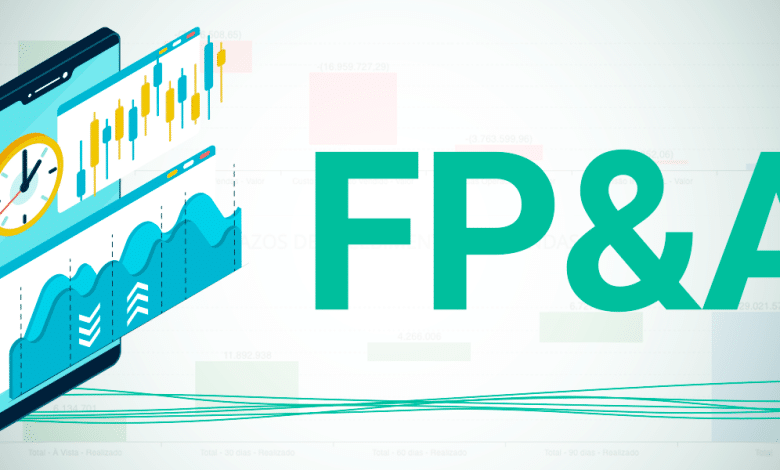
In the dynamic world of corporate finance, Financial Planning and Analysis (FP&A) plays a pivotal role by acting as the backbone for strategic decision-making. Companies often struggle with resource optimization and navigating complex financial landscapes, leading to inefficient capital use and strategic misalignment.
This blog explores how FP&A integrates planning, performance management, and financial analysis to overcome these challenges. Readers will journey through the core functions, responsibilities, and processes of FP&A, uncovering its strategic significance and the tools used to enhance efficiency and adaptability in ever-changing market conditions. Ultimately, this knowledge equips businesses to maximize profitability, manage risks, and achieve long-term success.
The Significance of FP&A in Corporate Finance
What is financial planning and analysis or FP&A, is crucial in the realm of corporate finance as it seamlessly integrates planning, forecasting, performance management, and financial analysis. Through FP&A, businesses can optimize their capital and resources, steering the organization towards strategic financial management goals.
FP&A teams scrutinize capital allocation to maximize shareholder value by evaluating returns across various business units and geographic areas.
FP&A teams are adept at analyzing capital allocation to ensure it’s being used most effectively to boost shareholder value. They evaluate the profitability and return on capital from different business units, products, and geographies, helping firms decide where best to invest their resources. This careful use of capital strengthens a company’s financial health and market position.
Support for strategic financial management
Beyond just capital, FP&A teams help identify underutilized or misallocated resources. By examining financials in detail, they help make adjustments that promote operational efficiency and competitiveness. They work closely with other departments like sales and operations, ensuring financial plans mesh with the company’s strategic vision. This collaboration ensures everyone is on the same page, increasing accuracy and impact.
Advanced analytics tools empower FP&A to make reliable forecasts, conduct scenario analyses, and manage risk by evaluating potential threats and opportunities instantly. These tools aggregate and analyze data comprehensively, allowing FP&A teams to create reliable forecasts, perform scenario analyses, and track performance in real-time. This capability aids in risk management by evaluating potential threats and opportunities, preparing companies for various scenarios.
Monitoring KPIs, FP&A verifies alignment with strategic objectives, offering actionable insights for necessary adjustments. They track key performance indicators (KPIs) to assess whether the company meets its strategic objectives. Analyzing financial reports and discovering areas for improvement, FP&A provides actionable insights for necessary changes, ensuring resources are used efficiently to meet strategic goals.
Core Functions and Responsibilities of FP&A
In the realm of corporate finance, Financial Planning & Analysis is an unsung hero, directing the financial compass of a company to ensure it stays on course amidst fluctuations and challenges. The core functions of FP&A are pivotal to this mission, as they provide the foundation for making informed strategic decisions.
Integrated Planning and Forecasting to Translate Strategic Plans into Measurable Strategies
The essence of FP&A lies in its ability to transform broad strategic goals into concrete, measurable plans through integrated planning and forecasting. This structured approach allows organizations to chart their future direction, ensuring that strategies are not just idealistic but grounded in realistic, attainable objectives. FP&A weaves together financial and operational goals to set the stage for synchronized efforts across departments.
Performance Management Aligning Financial and Operational Goals
As much as planning is crucial, aligning these plans with performance management is equally important. This is where FP&A acts as a bridge, connecting financial objectives with operational tactics. By fostering this alignment, organizations can optimize resources, thereby boosting efficiency and ensuring that every department marches to the same beat.
Financial Analysis Providing Insights Using Models and Data
A crucial element of FP&A is financial analysis, which is instrumental in navigating today’s data-driven business environments. Through complex models and analytical tools, FP&A professionals extract valuable insights from data to guide decision-making. According to the 2024 FP&A Trends Survey, about 64% of business decisions are now driven by data, indicating a strong shift towards reliance on analytics. However, the same survey reveals that FP&A professionals spend a significant portion of their time on data collection rather than insight generation, highlighting a potential area for process improvement. More details can be found in the [FP&A Trends Survey](https://fpa-trends.com/article/2024-fpa-trends-survey-results-unveiled).
Managing growth involves adapting to market changes by consistently updating plans to remain relevant.
FP&A also plays a critical role in managing growth and adaptability within an organization. As markets evolve and new challenges arise, FP&A must ensure that businesses are not just reactive but proactive in their approach to change. This involves constant monitoring and revising of plans to maintain relevancy in the face of new opportunities or threats. Cross-functional collaboration further enhances this capability, as FP&A teams engage closely with various departments like sales, marketing, and operations. Such collaboration enriches financial forecasts and budgets, supports agile decision-making, and enables businesses to quickly address market shifts.
Roles and Responsibilities of FP&A Experts
FP&A professionals are essential for transforming strategic objectives into practical financial plans through detailed budgeting and forecasting. By closely collaborating with departments like sales, marketing, and operations, they ensure these plans are comprehensive and aligned with the company’s overall strategy.
Budgeting and Forecasting with Rolling Forecasts
FP&A teams leverage advanced tools and technologies such as data analytics platforms and financial planning software, which offer real-time updates and facilitate automated reporting. This makes the budgeting process more efficient and accurate. Using rolling forecasts and scenario planning, FP&A professionals adapt to the dynamic business environment, refining financial models to align with current realities.
Decision Support Advising on Performance Improvement, Risk Minimization, and Opportunity Capture
FP&A professionals play a crucial role in decision support by advising on performance improvements, risk mitigation, and opportunity capture. They conduct thorough risk assessments and offer actionable strategies like hedging or diversification to minimize risks. By setting and monitoring key performance indicators (KPIs), they provide insights into business unit performance, suggesting areas for improvement.
Variance analysis aligns planned targets and actual performance to identify discrepancies and suggest improvements.
Variance analysis is also a critical task for FP&A professionals. By comparing actual performance against planned targets, they identify discrepancies and conduct root cause analyses to suggest strategic refinements. This ongoing process ensures the company’s financial health and addresses any deviations quickly.
Special Projects Including M&A Support and Market Research
FP&A professionals are also involved in special projects like supporting mergers and acquisitions (M&A) and conducting market research. In M&A, they perform due diligence, analyzing the financial health and market position of target companies. Through detailed financial modeling, they assess potential synergies and integration challenges, facilitating informed decision-making. The FP&A team conducts market research to grasp industry trends and competitive dynamics, helping companies seize new opportunities and mitigate risks. For more insights into FP&A roles, you can explore discussions on Reddit, where the community shares experiences related to translating business insights into actionable strategies.
The FP&A Cycle and Its Key Processes
In any corporate finance structure, the FP&A cycle plays a pivotal role. This cycle drives strategic decision-making by integrating several key processes that ensure financial plans align closely with business operations.
Planning and Budgeting with Goal-Oriented, Driver-Based Plans
- At the forefront is the development of goal-oriented plans and budgets. FP&A teams construct these plans using driver-based models that connect financial targets with essential business factors like sales and pricing. By pinpointing these key performance indicators, financial plans are crafted to support the organization’s overall objectives. Notably, 44% of FP&A teams have adopted this integration, highlighting its growing importance as emphasized in the research from FP&A Trends.
Scenario Modeling for Predictive Planning and What-If Scenario Analysis
- Scenario modeling provides sensitivity analyses and ‘what-if’ scenarios for anticipating business impacts. By leveraging advanced analytics and AI, FP&A teams can perform sensitivity analyses and generate ‘what-if’ scenarios, which help anticipate how different factors could impact the business. It’s a way of preparing for the unknown, ensuring that strategic plans remain robust and adaptable despite fluctuating market conditions. This ongoing cycle of testing and adaptation is crucial for risk management and strategic alignment.
Comprehensive Cash Flow Forecasting Across Business Activities
- Effective cash flow forecasting is fundamental, demanding real-time integration of data across various business fronts. By employing rolling forecasts that update periodically with new data, organizations can maintain a flexible and accurate understanding of their financial position. This approach not only supports efficient risk management but also prepares the company to tackle sudden changes promptly.
Connected Planning Integrating Finance and Operations
- The goal of these interconnected processes is to link finance with the core operational insights of the business. Achieving this requires a robust FP&A infrastructure that consolidates all necessary data into one platform, facilitating a seamless flow of information. By embracing technologies such as cloud-based Enterprise Performance Management (EPM) systems, companies gain real-time insights and advanced capabilities for scenario modeling, which enhance both decision-making efficiency and the alignment of global and local business strategies. However, as noted in the FP&A Trends survey, while many teams are advancing towards integrated methodologies, challenges around scenario execution highlight the need for continuous upskilling and change management initiatives. More detailed insights can be obtained from the FP&A Trends survey (https://fpa-trends.com/article/2024-fpa-trends-survey-results-unveiled).
Strategic Role and Impact of FP&A
In today’s fast-paced business world, the Financial Planning and Analysis (FP&A) function plays a pivotal role in driving companies toward success. As organizations grapple with a mix of uncertainties and risks, FP&A emerges as a key player, offering essential frameworks for managing change efficiently and strengthening a company’s ability to adapt.
The demand for skilled FP&A professionals is on the rise, with nearly half of CFOs expressing a pressing need for these experts to aid in strategic financial management. This growing demand illustrates how indispensable FP&A has become in fostering businesses’ agility in the face of changing market conditions.
Agile FP&A involves ongoing financial plan revisions, ensuring rapid strategy adjustments to market shifts. Scenario planning, a critical element of agile FP&A, prepares companies for a multitude of potential outcomes, from economic fluctuations to geopolitical uncertainties. This proactive approach helps maintain liquidity and financial stability, ensuring that resources are reallocated efficiently as needed.
FP&A teams analyze data and trends, crafting strategies for risk management and safeguarding financial health. By analyzing historical data, monitoring current market trends, and considering external factors, FP&A teams craft strategies to manage potential risks, collaborating closely with treasury departments to safeguard short-term financial health and ensure long-term sustainability.
Supporting strategic initiatives aimed at innovation and growth, the FP&A function performs rigorous financial analyses and forecasting. This practice not only reveals high-potential opportunities but also ensures resources are directed to projects that best align with the company’s long-term goals for sustainability, balancing current performance with future viability.
FP&A equips businesses with a forward-thinking approach to navigate the complex and unpredictable VUCA (Volatility, Uncertainty, Complexity, Ambiguity) environment effectively. Through detailed data analysis and scenario forecasting, organizations build resilience, positioning themselves well for sustained success in an ever-changing world.
Technological Tools for Modern FP&A
In the realm of financial planning and analysis (FP&A), the right tools and software can transform how organizations plan, model, and report on financial data. Dynamic planning is crucial, allowing FP&A teams to prepare for multiple scenarios beyond static forecasts. Advanced software solutions enable these teams to create adaptable models that anticipate a spectrum of potential outcomes, providing strategic preparedness.
Scenario analysis stands out as a best practice for effectively managing risks and opportunities. Tools like Prophix and JustPerform excel in offering comprehensive scenario planning capabilities. By leveraging real-time data integration, as seen with JustPerform and Datarails, FP&A teams can swiftly update scenarios in response to changing conditions, making decisions with agility and confidence. These platforms ensure forecasts are timely and precise, backed by the latest data.
Another essential aspect is the use of business intelligence tools and reporting software. Platforms such as Savant and Vena Solutions enhance financial modeling by integrating AI-powered analytics. This capability allows for processing large data volumes to uncover insights and predict trends, crucial for informed decision-making. Seamless integration with existing systems makes data extraction and analysis efficient, reducing the burden of model upkeep.
Modern FP&A tools emphasize collaboration and communication across departments. Solutions like Anaplan and Cube allow real-time data sharing and collaboration, aligning stakeholders with unified financial goals. This helps maintain consistent data integrity and relevance throughout the organization.
FP&A tools integrate AI and machine learning (ML) to further refine planning processes. Platforms like Savant and JustPerform automate complex data analysis, yielding insights free of human bias. This empowers FP&A teams to handle big data with precision, fostering a data-driven culture poised to meet market dynamics. These tools ultimately support informed decision-making that anticipates rather than simply reacts to changes.
Advanced Technologies in FP&A
In a world where data is more abundant and accessible than ever, the role of technology in Financial Planning and Analysis (FP&A) cannot be overstated. The right tools can transform raw information into actionable insights, driving smarter business decisions and fostering strategic growth.
The Vital Role of Software Tools
FP&A professionals rely on various software tools to streamline their work and increase efficiency. Tools like Planful and Anaplan are widely used in the industry. They assist in budgeting, forecasting, and planning through intuitive interfaces and robust data handling capabilities. These tools are essential for producing detailed financial models and performing scenario analyses that inform strategic decisions.
Moreover, many companies are adopting cloud-based solutions that facilitate better collaboration across departments. These platforms allow various corporate teams to access and share data, ensuring that everyone is working with the same information, which is crucial for maintaining goals alignment.
Emerging Technologies in FP&A
As businesses strive for a competitive edge, the integration of advanced technologies like artificial intelligence (AI) and machine learning is becoming more prevalent in FP&A. These technologies enhance predictive planning by identifying trends and patterns in large datasets that might be missed by traditional analysis. AI-driven tools can provide real-time insights, enabling quicker and more informed decision-making.
FP&A professionals must stay aware of these technological advancements and continually develop their skills to leverage new software effectively. This mindset of lifelong learning is important, considering the rapid pace of technological change in the field. As noted in discussions about FP&A career paths, staying updated with the latest tools and trends is vital for career advancement (source: https://www.reddit.com/r/FPandA/comments/q8cuty/the_first_510_years_of_your_career_in_corporate/).
In summary, embracing the power of modern FP&A tools not only improves workflow efficiency but also empowers professionals to provide valuable insights that can shape a company’s financial strategy and overall success.
The Future Outlook of FP&A
FP&A plays a critical role in shaping management decisions by providing data-driven insights. Through the use of advanced technologies like AI and Machine Learning, FP&A teams can automate routine tasks and focus on delivering predictive and prescriptive insights that enhance decision-making. As highlighted by [this source](https://www.blog.com), embracing these technologies can lead to cost reductions and improved forecast accuracy.
Integration of comprehensive tools and software is essential for FP&A’s success. IBM Watsonx Orchestrate and similar tools centralize data from multiple sources, facilitating better decision-making by providing actionable intelligence. This integration also allows FP&A teams to be more agile and adaptive in their strategies by leveraging modern financial planning tools and methodologies. By using automation, analytics, and dynamic dashboards, they maintain a competitive advantage, as noted by [this source](https://www.blog.com).
Furthermore, FP&A is crucial in enabling companies to adapt to economic and market changes, fostering long-term success. By harnessing external data, FP&A teams gain a deep understanding of business dynamics, enabling organizations to effectively capitalize on changes. Incorporating risk management and compliance processes ensures businesses remain resilient while pursuing growth opportunities, aligning with sustainability goals for ongoing success.
Youtube Videos
You can also refer to the following youtube videos in your article.
- https://www.youtube.com/watch?v=l-GElSaBC8o
Brief: Provides an overview of the practical responsibilities of FP&A professionals, aligning with the blog’s focus on understanding FP&A’s role in corporate finance.
- https://www.youtube.com/watch?v=gaKjMTBIn-g
Brief: Offers a comprehensive introduction to FP&A, detailing the roles, responsibilities, and skills required, which enhances understanding of FP&A’s role in corporate finance.
- https://www.youtube.com/watch?v=xN9wKEFYVCA
Brief: Explains the importance and functionality of FP&A within a company, which is directly relevant to the corporate finance insights required by the blog.
Reddit Threads
You can also refer to the following reddit threads in your article.
- https://www.reddit.com/r/FPandA/comments/1b4dute/is_a_career_in_corporate_finance_fpa_good/ :An intern in Corporate Finance, specifically FP&A, expressed concerns about staying in the role long-term despite hearing both positive and negative feedback. Some advantages of FP&A include excellent work-life balance and decent pay, as well as ample exposure to high-level players within the company. However, it can also be monotonous and, at times, stressful depending on the corporate culture. More on this discussion can be found here.
- https://www.reddit.com/r/FPandA/comments/q8cuty/the_first_510_years_of_your_career_in_corporate/ :A seasoned finance professional shared insights on career strategy within FP&A, emphasizing the significance of dedication in the early years to build essential skills that later enable career progression into roles such as VP, SVP, or CFO. They highlighted that the focus should be on what can be learned from each role to ensure long-term career success. Find the discussion here.
- https://www.reddit.com/r/FPandA/comments/17mb9ks/fpa_in_startup_vs_large_company_whats_your/ :Working in FP&A at different types of businesses varies significantly, with strategic finance roles in startups often encompassing broader responsibilities including M&A diligence and customer analysis. This dynamic role contrasts with more structured corporate FP&A positions that typically involve consolidation and reporting. More insights can be explored here.
- https://www.reddit.com/r/FPandA/comments/vp4tih/corporate_fpa_vs_operation_fpa/ :A discussion comparing corporate and operational FP&A highlighted the differences in roles, with corporate FP&A focusing on strategic advising and consolidating financial data, while operational FP&A involves more detailed engagement with business units and executives to drive decision-making and understand business operations. This exchange reveals more distinctions.
- https://www.reddit.com/r/FPandA/comments/1769gxe/a_guide_on_mbas_for_fpa_and_corporate_finance/ :FP&A professionals often engage in budget planning, variance reporting, and forecast updates. They play a crucial role in translating business insights into actionable strategies, ensuring financial goals align with operational objectives, and supporting strategic analysis to improve decision-making. This reflective post illuminates these responsibilities.
- https://www.reddit.com/r/FPandA/comments/1ay5w24/what_is_the_ideal_career_path_of_fpa/ :A thread exploring career paths in FP&A suggested starting in large companies as financial analysts and progressing through roles to eventually become a CFO at smaller companies. The advice also emphasized gaining exposure to different areas of finance before deciding on a specialization in the corporate ladder. Further career insights are available here.
Research Data
You can also refer to the following research in your article.
- Research Source : https://www.ibm.com/think/insights/fpa-plans-with-ai-powered-forecasts
Research Data Points:
- On average, adopters of augmented intelligence deploy AI across 40% of finance function workflows.
- Organizations that have infused AI into their finance processes have reduced close cycle times and uncollectible accounts receivable balances.
- AI-powered forecasts should typically draw data from at least twice the number of time periods you are trying to forecast, to account for trends and seasonality.
- A scalable AI-powered forecasting solution can handle large datasets and ignore specific time periods, and has machine-learning capabilities to adjust outliers.
- AI algorithmic forecasting can enhance the allocation of resources by providing data-driven insights that align with real-time market trends and internal metrics.
- Research Source : https://fpa-trends.com/article/2024-fpa-trends-survey-results-unveiled
Research Data Points:
- Only 35% of FP&A professionals’ time is spent on high-value tasks like generating insights, while too much time is devoted to data collection and validation.
- 64% of decisions are now data-driven, indicating a 12% increase from the last year.
- 63% of respondents struggle to predict beyond six months, and for 29%, finalizing a forecast takes more than 10 days.
- 22% can run scenarios within a day, but 21% are still unable to run them at all.
- Only 19% of FP&A teams report to be optimized to perform, and the demand for Business Partnering skills has increased by 9% to 50%.
- Research Source : https://fpa-trends.com/article/2024-fpa-trends-survey-results-unveiled
Research Data Points:
- Only 35% of FP&A professionals’ time is spent on high-value tasks like generating insights, while too much time is devoted to data collection and validation.
- 64% of decisions are now data-driven, indicating a 12% increase from the last year.
- 63% of respondents struggle to predict beyond six months, and for 29%, finalizing a forecast takes more than 10 days.
- 52% of FP&A teams still use Excel for planning, and the adoption of Artificial Intelligence (AI) is low at just 6%.
- 44% of participants are already running integrated models, and 34% are planning to implement them.
- Research Source : https://corporatefinanceinstitute.com/course/working-in-fpa/
Research Data Points:
- FP&A is considered one of the most important, yet underperforming, functions within finance according to Chief Financial Officers (CFOs).
- The FP&A function is crucial for companies of various sizes and industries and can provide significant benefits.
- Key technical skills for FP&A professionals include financial modeling, data analysis, budgeting, and forecasting.
- Key non-technical skills for FP&A professionals include problem-solving, communication, and strategic thinking.
- The Corporate Finance Institute’s FP&A courses are accredited by the Better Business Bureau (BBB), the CPA Institutions in Canada, and the National Association of State Boards of Accountancy (NASBA) in the USA.
- Research Source : https://corporatefinanceinstitute.com/resources/fpa/fpa-at-the-forefront-part-1/
Research Data Points:
- A recent survey of CFOs reported that nearly half (49%) expressed a pressing need for FP&A expertise.
- FP&A teams increasingly rely on their business’s financial and operational data to gain deeper insights and identify new opportunities.
- Digital technology integration enhances FP&A’s capabilities through, for example, platforms that automate numerous routine finance and accounting tasks and provide sophisticated, real-time insights into financial KPIs.
- The trend of integrating environmental, social, and governance (ESG) factors into FP&A is gaining momentum, mirroring the increasing focus of society and investors on sustainable and responsible business practices.
- The evolution in FP&A’s role not only enhances its strategic importance but also sets the stage for a deeper exploration of the new skills and capabilities essential in this transformed landscape, including financial modeling, data analytics, strategic business acumen, technological proficiency, cross-functional collaboration, communication, and ESG analysis.




